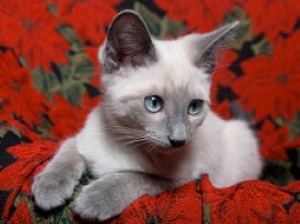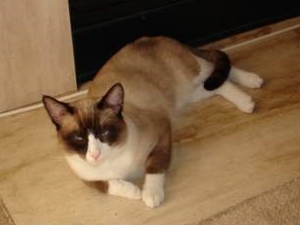- Home
- Meezer Musings
- October 2019
Meezer Musings: October 2019
Safety First, Last, and Always
Safety is as simple as ABC - Always Be Careful.
Author Unknown
Welcome to this month's Meezer Musings! It's the end of October, Halloween is almost upon us, and cat safety has been much on my mind recently for all sorts of reasons.
This month we're taking an all-round look at keeping your cats secure, safe and happy, wherever they might be. Halloween brings its own challenges, so we have some seasonal topical tips for you too.
Recently I was sent some flowers by a kind friend, and I was delighted to see, on the side of the delivery box, a warning about lilies being harmful to cats.
Far too many people still don't know how dangerous lilies are, so it's good to see florists doing their bit to spread this most important message, especially as lilies are often included in mixed bouquets.
We'll return to lilies and other indoor hazards later. But first, let's take a look at the great outdoors.
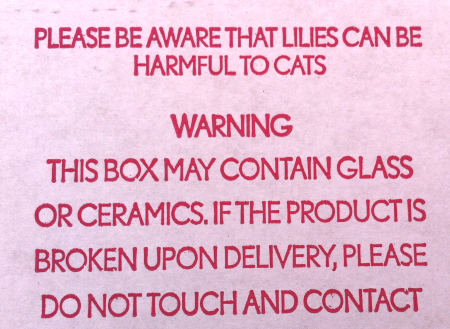 Lily warning on a flower delivery box
Lily warning on a flower delivery boxChanges in Latitude, Changes in Attitude
Dangers to cats have always existed, both outside and inside the home. Opinions on whether or not cats should be kept indoors seem to vary a lot by country, so it's worth taking a look at these differences before going further.
In the UK, it's historically been acceptable for cats to be allowed outside. In most areas of Britain there are no large wild predators, and no rabies, but outdoor cats still face all sorts of dangers including other cats, loose dogs, increasingly fast, busy traffic, and (at best) thoughtless and (at worst) murderous humans.
Horrifyingly, there have been a number of cases of cats being shot, and one particularly nasty ongoing series of episodes of cats being deliberately mutilated and killed.
In the United States and Canada it's much more usual for cats to be kept inside because in addition to the hazards above, in country areas (and even some urban ones) large wild predators can be a real threat.
Most, if not
all, pedigree and specialist rescue centers in the USA make it a condition of adoption that rescue cats must be kept inside.
Other countries have mixed views on whether cats should be kept indoors or not. Australia is particularly concerned about the dangers to wildlife (birds, fish, rabbits, small reptiles) from cats.
Some areas even have strict overnight curfews in the hours from dusk to dawn, during which cats must by law be kept indoors to protect indigenous wildlife from hunting cats.
The Great Outdoors? Keeping Your Cat Safe
Sunshine and fresh air, though, are good for cats, just as they are for humans.
So what can you do if you'd like your cats to have an
outdoor experience without worrying about them and any dangers
they might be facing? Let's take a look at some of the choices.
Cats in Harness
The easiest and cheapest option is to train your cat to walk in a
harness, so they can be kept near you when you're out in the garden or
yard, or even taken out for walks.
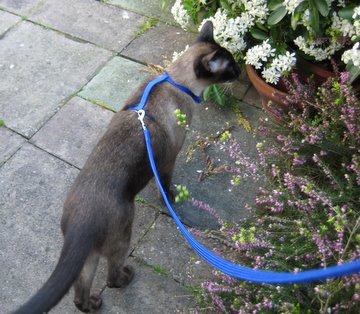 Bandit in a small dog harness
Bandit in a small dog harnessImage copyright © Life with Siamese Cats
When I first got Bandit I trained him quite successfully with a small dog harness but it wasn't an ideal design (above) as he managed to wriggle out of it twice.
A better option are harnesses created specifically for cats, like the one shown below, produced by Butterfly Cat Jackets for their own strong, active, Bengal cats. This is a much better design as the neck and body areas fasten with Velcro so can be adjusted to fit very snugly.
 Harness from Butterfly Cat Jackets
Harness from Butterfly Cat JacketsImage copyright © Life with Siamese Cats
Butterfly Cat Jackets say they've never known any cats to escape from their harnesses (although, where cats are concerned, nothing is 100% foolproof) and these are strong and well-made.
They're available in a variety of fun patterns and colors and are not overly expensive. If you'd like to know more, you can find them on Facebook or on their own Butterfly Cat Jackets website.
Catios. Patios for Cats
Catios (cat-safe enclosures made from wire netting or chain-link fencing) are a good choice for those with small areas of outside space.
Some years ago, one of our visitors posted some photos of her cat Spencer enjoying his garden catio, and catios have become increasingly popular since then.


Spencer enjoying his catio. You can just see the chain-link fence
behind the rush matting that disguises it.
Photos with thanks to and © Cori Littlejohn
Catios are usually constructed to join on to, or surround, a house or
apartment so that a cat can access them through a cat-flap or window,
but if you have the space, you can also find free-standing ones that can
be erected anywhere.
If you'd like to learn more and see all the different designs, there are lots of good examples and ideas on this page from Catio Spaces.
Fencing a Yard or Garden for a Cat-Safe Area
Another way of creating a safe outdoor space for your cats is to enclose your whole yard or garden in cat-safe fencing. There are a number of companies now who either provide the materials for you to do this yourself, or will build the whole enclosure for you.
Purr...fect Cat Fence can either be built as a complete, free-standing fence or added to the top of your existing fence to make it cat-proof.
As you can see, it works by means of spring-loaded fence arms that curve inwards, preventing a cat from climbing over it. A cat's weight swings the horizonal arm downwards (returning the cat to the ground) and the arm then returns to its original position.
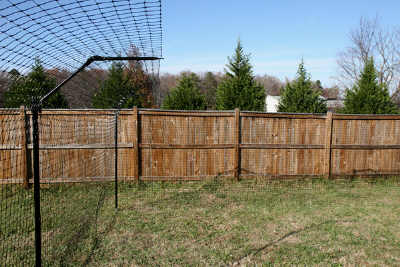 Purr...fect Cat Fence
Purr...fect Cat FenceThe photo above is of the free-standing version, while below you can see the top added to an existing fence. In both cases, the fence blends well with the landscape and at a distance is almost invisible.
 Purr...fect Cat Fence
Purr...fect Cat FenceThis version added to top of existing wooden fence
Get Your Cats to Come Running! A Useful Tip
Years ago, my hairdresser, who at the time owned two Burmese cats, told me that she'd trained her cats to come to a dog whistle. I used this training technique very effectively with Bandit, who'd come racing from wherever he happened to be whenever he heard the whistle.
I've recently seen the same tip from someone who used a small hand bell to train her cats. Here's how. Whenever you feed your cats or give them a treat, blow a whistle (or ring a bell) first. Eventually the cats will associate the sound with food, and come running whenever they hear it.
This is an especially useful tool to use if your cats escape (or even if you can't find them inside your house) so it's well worth investing a small amount of time and money to train your own cats.
Indoor Hazards: Plants, Poisons and Other Potential Accidents
Returning to lilies ... lilies, and especially their pollen, are deadly to cats. Particularly dangerous
varieties are Easter lilies, Tiger lilies and others with flowers that open up to a long stamen and pollen, but all members of the lily family, and all parts of the plant, are toxic if eaten as they affect the kidneys and in extreme cases, shut them down altogether.
Lilies are
very often included in mixed bouquets of flowers, and many people still have no idea how dangerous lilies are to cats - sadly some of our readers have lost their cats to lily poisoning, or otherwise endured long, difficult and expensive stays in veterinary hospitals.
 The Easter Lily - just one of many members of the lethal lily family
The Easter Lily - just one of many members of the lethal lily familyphoto: © iStockphoto | Timothy Epp
Many other common flowers and house plants pose dangers to cats if eaten and a full, and very long, list from the ASPCA can be found here.
Lysol – and Other ‘Sols’
Our next warning relates to liquids containing phenols - the most common ones are disinfectants like Lysol, Pine-sol and Dettol, which can burn the mouth and gastric tract and do enormous damage to a cat's nervous system and liver if swallowed, with some cases being fatal.
I first heard about this in a report about a cat that walked past an automatic Lysol anti-bacterial handwash dispenser, and got a drop of the soap on his coat. He then groomed his coat, and fell seriously ill. Happily he survived with urgent veterinary treatment, but it could have turned out very differently.
Pain Medication
It goes without saying that all human medications should be kept out of the reach of cats but one often overlooked problem is that of hand-applied creams and gels containing ibuprofen.
Hands should always be washed after applying any such pain medications (for our own sakes, as well as for the health of our cats) as failing to do so can transfer the medication to our cats' coats where again, it can be licked off and cause harm.
Watch Out, Kittens About
Our final warning is about the hazards of washers and tumble driers.
Cats and especially kittens seem to love these and there are horror stories of kittens finding their way into washers or driers without being seen by their owner, who then switched the machine on without realising their cat was inside.
So always check your washers and driers for cats and kittens before starting a wash or dry cycle.
Topical Tips for Halloween
Decorated houses, trick-or-treating, excited visitors, noise, masks, costumes, candy, pumpkins and spiders galore ... Halloween is all great fun for those taking part! But there's often a lot of unusual activity and it can be a confusing, even frightening time for pets.
Here in the UK we have an additional celebration, Guy Fawkes' Night on November 5th, involving bonfires and fireworks. What used to be purely a one-night event often now turns into several weeks of firework displays, starting at the end of October and continuing well into November.
But whether you're celebrating on October 31st or November 5th or some other time completely - all of it can cause a great deal of extra stress and anxiety for our pets.
So before you head off to enjoy some seasonal fun,
here are our topical tips for keeping your cats calm, happy and safe.
- Where are your cats? At Halloween you're likely to be opening your front door more often than usual, and it's easy to forget to check where your cats are. So make sure, before the fun begins, that they're safely enclosed in a room where they won't be affected by all the comings and goings and, most importantly, won't be able to escape.
- Make them a hideout. Make a safe space in your quietest room with beds, toys, food, water, litter tray and any other comforts to keep your cats happy and away from the commotion.
- Keep them quiet and calm. Close windows and doors and draw curtains or blinds to help limit the noise that comes into the house. Pheromone plug-ins or sprays like Feliway can help keep cats calm - spray it in your safe space. Staying calm yourself and not reacting to loud noises also helps to reassure your cat that nothing is badly wrong.
- Check decorations and costumes. Lighted candles and lanterns should be placed out of your pet's reach to avoid them being knocked over. Pet costumes, while cute, should be checked to make sure they're comfortable, allow your pet to see and breathe easily, and only used for a very short time.
- Candy can be toxic. Chocolate and any (usually sugar-free) candy containing xylitol are poisonous to cats and dogs, so keep all candy out of reach of your pets. It's a very good excuse to eat any leftovers yourself!
Tail End ...
That's it for this month. Happy Halloween! We'll be back towards the end of November for some festive fun, looking towards the holiday season and Christmas.
Meanwhile, enjoy the spooky festivities and, as our opening quote says, remember your ABCs - Always Be Careful out there, and stay safe, secure, and warm!
Caroline
Missed a Meezer Musings? A list of previous newsletters can be found here.
Some of the articles and newsletters on this site may contain links to products I think you may enjoy. If
you purchase through these links I receive a small commission, but there's
no extra cost to you. Find out more on the Affiliates Disclosure page.
Have You Discovered Our Newsletter?
If not, why not? Subscribe to our email newsletter, Meezer Musings, to stay in touch, be the first to see new information and pages as they come out, and read the things we only talk about in the newsletter.
Learn more about it on our Newsletter Sign-Up page.
